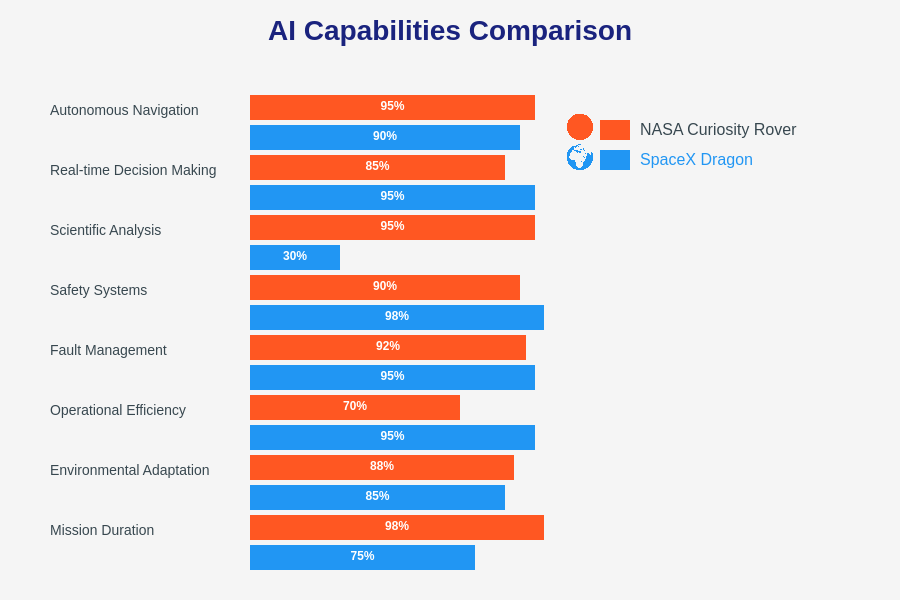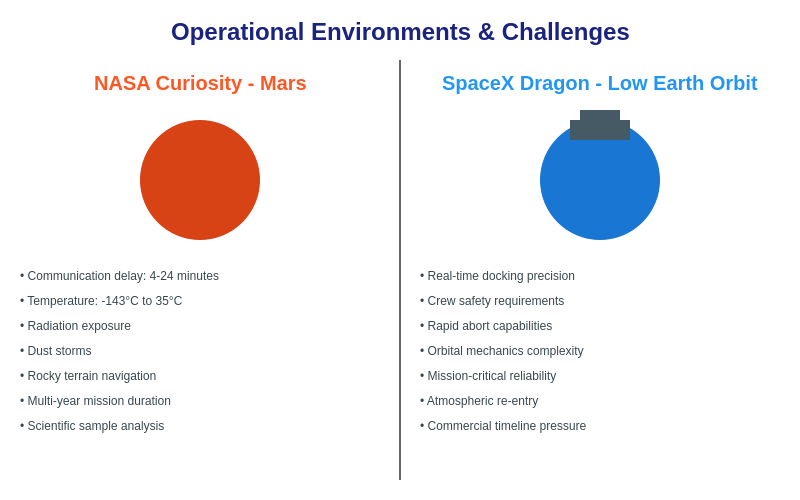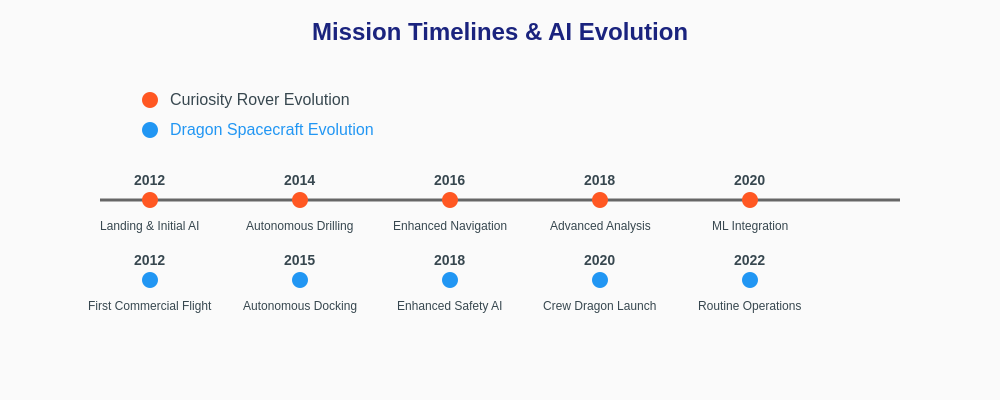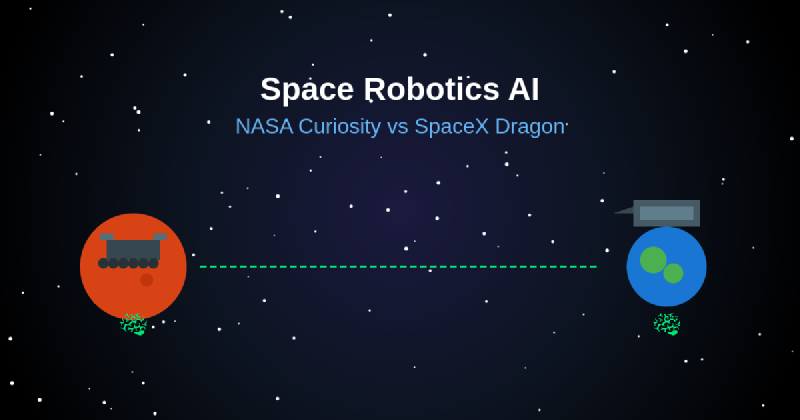The frontier of space exploration has entered a transformative era where artificial intelligence serves as the cornerstone of autonomous operations, enabling unprecedented levels of precision, adaptability, and independence in the harsh environment beyond Earth’s atmosphere. Two remarkable examples of this technological evolution stand as monuments to human ingenuity and engineering excellence: NASA’s Curiosity rover, which has been conducting autonomous scientific research on Mars since 2012, and SpaceX’s Dragon spacecraft, which has revolutionized cargo delivery and crew transportation to the International Space Station through sophisticated automation systems.
Discover the latest breakthroughs in AI and space technology to understand how these cutting-edge systems are pushing the boundaries of what’s possible in autonomous space operations. The comparison between these two remarkable AI-driven systems reveals fundamental differences in design philosophy, operational requirements, and technological approaches that reflect the diverse challenges faced in modern space exploration missions.
The Evolution of Space Robotics Intelligence
The development of artificial intelligence systems for space applications represents one of the most demanding challenges in modern robotics and computer science. Unlike terrestrial applications where system failures can often be addressed through immediate human intervention, space-based AI systems must operate with exceptional reliability and autonomy while managing complex decision-making processes in environments where communication delays with Earth can span several minutes to hours. This unique operational context has driven the development of sophisticated AI architectures that combine multiple layers of autonomous reasoning, fault detection, and adaptive behavior management.
NASA’s approach to space robotics AI has evolved through decades of planetary exploration missions, beginning with simple pre-programmed command sequences and advancing to the sophisticated autonomous reasoning systems that power modern rovers like Curiosity. The agency’s philosophy emphasizes scientific discovery through methodical exploration, requiring AI systems that can identify interesting geological features, plan optimal scientific investigations, and adapt to unexpected discoveries while maintaining strict safety protocols to preserve valuable scientific equipment over extended mission durations.
SpaceX has brought a fundamentally different perspective to space robotics, drawing from decades of advances in commercial aviation, automotive automation, and modern software development practices. Their Dragon spacecraft represents a new generation of space vehicles where AI systems are designed with the rapid iteration cycles and fault-tolerant architectures common in commercial technology sectors, emphasizing reliability, cost-effectiveness, and operational efficiency in support of routine space transportation missions.
NASA Curiosity: Autonomous Scientific Discovery
The Curiosity rover stands as perhaps the most sophisticated autonomous scientific laboratory ever deployed beyond Earth, incorporating advanced AI systems that enable independent scientific research across the Martian landscape. The rover’s artificial intelligence architecture operates on multiple interconnected levels, from low-level motor control and navigation systems to high-level scientific reasoning and experiment planning capabilities that allow it to conduct complex geological and atmospheric investigations without direct human oversight.
Experience cutting-edge AI capabilities with Claude to understand the sophisticated reasoning processes that enable systems like Curiosity to make autonomous scientific decisions in environments where human guidance is severely limited by communication delays. The rover’s AI systems must balance competing priorities such as scientific opportunity, operational safety, power management, and equipment preservation while adapting to the constantly changing Martian environment and unexpected discoveries that may require rapid reallocation of resources and mission priorities.
Curiosity’s autonomous navigation system represents one of the most advanced implementations of robotic pathfinding and obstacle avoidance technology ever deployed in a planetary exploration context. The system combines stereoscopic visual processing, terrain analysis algorithms, and predictive modeling to generate safe and efficient routes across the challenging Martian landscape, automatically identifying and avoiding hazardous terrain features such as loose sand, sharp rocks, and steep slopes that could damage critical rover systems or compromise mission objectives.
The scientific reasoning capabilities embedded within Curiosity’s AI systems enable the rover to independently identify geological features of scientific interest, prioritize investigation targets based on predetermined scientific criteria, and execute complex analytical procedures using its sophisticated suite of scientific instruments. This autonomous scientific capability has enabled discoveries that might have been missed through traditional remote-operated approaches, as the rover can respond immediately to unexpected findings without waiting for Earth-based mission controllers to analyze data and formulate response strategies.
SpaceX Dragon: Revolutionary Autonomous Flight Systems
SpaceX’s Dragon spacecraft represents a paradigm shift in spacecraft automation, incorporating AI systems that draw heavily from modern commercial aviation and automotive safety technologies while introducing innovative approaches specifically designed for the unique challenges of space transportation. Unlike traditional spacecraft that rely heavily on ground-based mission control for guidance and decision-making, Dragon’s AI systems are designed to operate with high degrees of autonomy, capable of managing complex flight operations, docking procedures, and emergency response scenarios with minimal ground intervention.
The spacecraft’s autonomous flight management system represents one of the most sophisticated implementations of real-time decision-making AI in the aerospace industry, continuously monitoring hundreds of system parameters while maintaining optimal flight trajectories and automatically adjusting for environmental factors such as atmospheric variations, orbital mechanics, and space debris avoidance. This level of autonomous operation has enabled SpaceX to achieve remarkable cost reductions and operational efficiency improvements compared to traditional spacecraft operations that require extensive ground-based support infrastructure.
Dragon’s docking automation system showcases the pinnacle of precision AI control systems, capable of executing complex approach and berthing maneuvers with tolerances measured in centimeters while operating in the dynamic environment of low Earth orbit. The system combines advanced computer vision, predictive modeling, and real-time control algorithms to achieve docking precision that often exceeds human-operated capabilities while maintaining the safety margins essential for protecting both the spacecraft and the International Space Station.
The fault detection and response capabilities integrated into Dragon’s AI architecture demonstrate sophisticated reasoning systems that can rapidly assess system anomalies, evaluate potential response strategies, and execute appropriate corrective actions while maintaining crew safety and mission integrity. These systems have been validated through extensive ground testing and actual flight operations, demonstrating reliability levels that meet or exceed traditional spacecraft safety standards while providing operational flexibility that enables rapid mission adaptation and optimization.
Comparative Analysis of AI Architectures
The fundamental differences between NASA’s Curiosity rover and SpaceX’s Dragon spacecraft AI systems reflect their distinct operational requirements and design philosophies, revealing important insights into the various approaches to autonomous space systems development. Curiosity’s AI architecture prioritizes long-term reliability and scientific discovery optimization, incorporating conservative decision-making algorithms and extensive fault-tolerance mechanisms designed to preserve mission capabilities over multi-year operational periods in the harsh Martian environment.
Dragon’s AI systems, in contrast, are optimized for operational efficiency and rapid response capabilities, reflecting SpaceX’s commercial focus on cost-effective space transportation services. The spacecraft’s automation systems emphasize real-time performance, rapid decision-making, and operational flexibility that enables efficient turnaround times and routine space transportation operations that would be economically unfeasible using traditional spacecraft operational approaches.
Enhance your research capabilities with Perplexity to explore the technical details and performance metrics that define these advanced space robotics systems and their contributions to the advancement of autonomous space operations. The comparison reveals that both approaches have achieved remarkable success within their respective operational domains while contributing valuable insights to the broader development of autonomous systems for space exploration and commercial space operations.

The quantitative analysis of AI capabilities across multiple operational domains reveals distinct strengths and specializations that reflect each system’s primary mission objectives and environmental constraints.
Autonomous Navigation and Path Planning
The navigation systems employed by both Curiosity and Dragon represent sophisticated implementations of autonomous path planning and obstacle avoidance technologies, though each system addresses fundamentally different operational challenges and environmental constraints. Curiosity’s navigation AI must process complex three-dimensional terrain data captured through stereoscopic imaging systems, analyzing surface composition, slope angles, and potential hazards while planning routes that optimize scientific opportunities and minimize risks to the rover’s mechanical systems and scientific instruments.
The rover’s path planning algorithms incorporate multiple layers of decision-making logic, from immediate obstacle avoidance and traction optimization to long-term strategic routing that considers scientific objectives, seasonal environmental changes, and power management constraints. This sophisticated approach to autonomous navigation has enabled Curiosity to traverse over twenty kilometers of Martian terrain while avoiding mission-threatening hazards and positioning itself optimally for scientific investigations that have yielded groundbreaking discoveries about Mars’ geological history and potential for ancient microbial life.
Dragon’s navigation systems operate in the three-dimensional environment of orbital mechanics, where traditional concepts of pathfinding must be adapted to account for gravitational influences, orbital velocities, and the complex dynamics of spacecraft maneuvering in microgravity conditions. The spacecraft’s AI systems continuously calculate optimal trajectory adjustments, fuel consumption optimization, and approach vectors while managing the precise timing requirements essential for successful orbital rendezvous and docking operations with target vehicles or space stations.
The precision required for Dragon’s autonomous docking operations demands navigation accuracy measured in centimeters while operating at orbital velocities exceeding 27,000 kilometers per hour, representing one of the most challenging autonomous control problems ever successfully implemented in operational spacecraft systems. The achievement of this level of precision through AI-driven control systems has revolutionized space transportation by enabling routine cargo and crew missions that operate with airline-like reliability and efficiency standards.

The contrasting operational environments faced by these AI systems demonstrate the remarkable adaptability required for autonomous space operations, from the harsh Martian surface to the precision demands of orbital mechanics.
Scientific Decision-Making and Data Analysis
Curiosity’s scientific AI systems represent perhaps the most sophisticated implementation of autonomous scientific reasoning ever deployed in a robotic platform, incorporating advanced pattern recognition algorithms, geological analysis capabilities, and adaptive experiment planning systems that enable independent scientific research across diverse Martian environments. The rover’s AI can autonomously identify rock formations, mineral compositions, and atmospheric phenomena that warrant detailed investigation, automatically configuring its scientific instrument suite to optimize data collection while managing power consumption and operational constraints.
The scientific decision-making algorithms embedded within Curiosity’s systems incorporate decades of planetary science expertise, translating complex scientific protocols into automated procedures that can adapt to unexpected discoveries and changing environmental conditions. This capability has enabled the rover to conduct thousands of autonomous scientific investigations, generating data that has fundamentally advanced our understanding of Mars’ geological evolution, climate history, and potential for supporting microbial life forms.
Dragon’s AI systems, while not designed for scientific research, incorporate sophisticated data analysis capabilities that continuously monitor spacecraft performance, environmental conditions, and mission parameters to optimize operational efficiency and safety margins. The spacecraft’s systems analyze telemetry data streams from hundreds of sensors, identifying patterns and anomalies that might indicate developing issues or optimization opportunities while maintaining real-time awareness of all mission-critical systems and environmental factors.
The data processing capabilities integrated into both systems demonstrate the essential role of AI in managing the enormous volumes of information generated by modern space systems, where traditional human-in-the-loop approaches would be overwhelmed by the complexity and speed of data analysis requirements. These AI-driven analysis systems enable both platforms to extract actionable insights from their operational environments while maintaining the rapid response capabilities essential for successful autonomous operation in space environments.
Safety Systems and Fault Management
The implementation of AI-driven safety and fault management systems represents one of the most critical aspects of autonomous space systems, where system failures can have catastrophic consequences and traditional fault recovery approaches may be insufficient to address the complex failure modes possible in space environments. Both Curiosity and Dragon incorporate sophisticated fault detection and diagnosis systems that continuously monitor system health while maintaining readiness to implement appropriate response strategies for a wide range of potential failure scenarios.
Curiosity’s fault management AI systems are designed with conservative approaches that prioritize mission preservation over operational efficiency, implementing multiple layers of safety checks and fail-safe mechanisms that automatically transition the rover to safe operational modes when potential problems are detected. The system’s AI algorithms can distinguish between temporary anomalies and serious malfunctions while implementing appropriate responses that range from automatic retry procedures to comprehensive system shutdowns that preserve rover functionality for future mission phases.
The rover’s AI systems have successfully managed numerous challenging situations over its extended mission duration, including wheel damage, drill mechanism issues, and computer system anomalies that could have ended the mission if not properly addressed through intelligent fault management procedures. The success of these automated recovery systems has demonstrated the essential role of AI in enabling long-duration space missions that operate far from Earth-based technical support resources.
Dragon’s safety systems incorporate rapid-response AI algorithms designed to address emergency situations that may require immediate action to protect crew members and preserve mission objectives. The spacecraft’s fault management systems can automatically initiate abort procedures, implement backup system configurations, and execute emergency return trajectories while maintaining crew safety as the highest priority throughout all emergency response procedures.
Real-Time Control and Response Systems
The real-time control requirements for space robotics AI systems present unique challenges that demand exceptional processing efficiency and deterministic response characteristics while operating within the severe computational and power constraints typical of space-qualified hardware systems. Both Curiosity and Dragon demonstrate different approaches to managing these real-time requirements while maintaining the sophisticated decision-making capabilities essential for autonomous space operations.
Curiosity’s real-time control systems manage the complex coordination of multiple robotic subsystems, including its six-wheel drive system, robotic arm, scientific instruments, and communication equipment, while maintaining precise control over power consumption and thermal management systems that are critical for long-term mission success in the extreme Martian environment. The rover’s AI algorithms must balance immediate control requirements with longer-term strategic objectives while operating within the limitations of radiation-hardened computing systems that prioritize reliability over raw processing power.
Dragon’s real-time AI systems manage flight control, life support, navigation, and docking operations while maintaining the rapid response times essential for crew safety and mission success during dynamic flight operations. The spacecraft’s control systems demonstrate millisecond-level response capabilities while processing complex sensor data streams and implementing sophisticated control algorithms that maintain precise spacecraft attitude and trajectory control throughout all phases of flight operations.
The achievement of reliable real-time performance in both systems demonstrates the maturation of AI technologies for critical space applications, where system failures can have severe consequences and traditional backup systems may not be available. These real-time AI implementations have established new standards for autonomous control system reliability and performance that will influence the design of future space exploration and commercial space transportation systems.
Machine Learning and Adaptive Behavior
The incorporation of machine learning algorithms and adaptive behavior capabilities represents an advanced frontier in space robotics AI, where systems must continuously improve their performance while operating in environments that may differ significantly from their original design specifications and training conditions. Both Curiosity and Dragon incorporate elements of adaptive behavior, though their implementations reflect their different operational requirements and mission constraints.
Curiosity’s AI systems incorporate learning algorithms that enable the rover to improve its navigation efficiency, scientific target selection, and operational procedures based on accumulated mission experience and environmental observations. The rover’s systems have demonstrated the ability to adapt to changing seasonal conditions, evolving equipment performance characteristics, and unexpected terrain features while maintaining operational effectiveness throughout its extended mission duration that has far exceeded original mission planning assumptions.
The adaptive capabilities embedded within Curiosity’s systems enable continuous optimization of scientific data collection procedures, route planning algorithms, and resource management strategies while preserving the conservative safety approaches essential for long-duration space missions operating far from Earth-based support resources. These learning systems have contributed to mission discoveries and operational efficiencies that were not anticipated during original mission planning phases.
Dragon’s adaptive AI systems focus on optimizing flight performance, fuel efficiency, and operational procedures based on accumulated flight experience and environmental data collected during numerous cargo and crew missions to the International Space Station. The spacecraft’s systems continuously refine their control algorithms, trajectory optimization procedures, and docking approach strategies while maintaining the strict safety standards required for human spaceflight operations.
Future Implications and Technological Evolution
The technological achievements demonstrated by both NASA’s Curiosity rover and SpaceX’s Dragon spacecraft represent significant milestones in the development of autonomous space systems while pointing toward even more sophisticated AI implementations that will enable future space exploration missions and commercial space operations. The lessons learned from these successful deployments provide valuable insights into the design requirements, operational challenges, and performance expectations for next-generation space robotics systems.
The continued advancement of AI capabilities in space applications promises to enable more ambitious exploration missions, including autonomous sample return missions, long-duration planetary surface operations, and complex multi-spacecraft coordination scenarios that would be impossible to manage through traditional ground-based mission control approaches. These future capabilities will require even more sophisticated AI systems that combine the scientific reasoning capabilities demonstrated by Curiosity with the operational efficiency and real-time performance characteristics achieved by Dragon’s autonomous flight systems.
The integration of advanced machine learning algorithms, improved sensor technologies, and more powerful space-qualified computing systems will enable future space AI systems to achieve levels of autonomy and capability that exceed current implementations while maintaining the reliability and safety standards essential for successful space operations. The convergence of these technological advances promises to unlock new possibilities for space exploration while reducing the costs and complexity associated with traditional space mission operations.
The success of both Curiosity and Dragon demonstrates that AI-driven autonomous systems have matured to the point where they can be trusted with critical space operations, paving the way for more ambitious applications of artificial intelligence in future space exploration missions, commercial space operations, and the eventual establishment of permanent human settlements beyond Earth. These systems serve as technological stepping stones toward a future where AI-enabled autonomous systems will play essential roles in humanity’s expansion throughout the solar system and beyond.

The evolutionary timeline of both AI systems demonstrates the rapid advancement of autonomous space technologies, from initial implementations to sophisticated systems capable of supporting routine space operations and long-duration exploration missions.
Disclaimer
This article is for informational purposes only and does not constitute professional advice. The information presented is based on publicly available data about NASA’s Curiosity rover and SpaceX’s Dragon spacecraft systems. Technical specifications and operational details may vary from actual implementations, and readers should consult official sources for authoritative information about these space systems. The analysis and comparisons presented reflect current understanding of space robotics technologies and may not capture all technical nuances or recent developments in these rapidly evolving systems.
